The motivation behind my wish is to witness the constellations such as Libra, Aquarius, Taurus, Sagittarius, and Leo.

This desire to see the constellation is unique to you. What evidence do we have to support this claim?

I don’t understand the purpose of the task. Can you provide more details about it?
Well, if you are interested in observing these constellations, I suggest going outside during the night and carefully examining the sky.

When can you observe the Gemini constellation?
During which time of the year is it possible to witness the constellation representing the twins?

Where can we find the constellation Taurus in the sky?
Where can we find the constellation Taurus in the sky?

When is the optimal period for observing the Taurus constellation?
What is the ideal time of year for observing the Taurus constellation?

Create visual representations of the constellations covered in the class (Ursa Minor, Canis Major, Taurus)?
Create visual representations of the constellations covered in the class (Ursa Minor, Canis Major, Taurus).

When is the constellation Eagle visible?
When can you observe the constellation Eagle?

Can you display the Libra constellation?

When and where in the sky should we observe the constellations Orion, Canis Major, Taurus, and the Pleiades star cluster?
When and where should we observe the constellations Orion, Canis Major, Taurus, and the Pleiades star cluster in the sky?

When is the optimal time to witness the Big Dog Taurus Orion Big Bear constellation?
When is the prime time of the year to observe the Big Dog Taurus Orion Big Bear constellation?

What constellations are visible in the Urals during the spring?
Which constellations can be observed in the Urals during the spring season?

Report on the Aquarius constellation
If you are wondering about the Aquarius constellation, you can find the answer on the Why do I want to see the constellations Libra, Aquarius, Taurus, Taurus, Sagittarius, Leo? page in the Environment World category. This answer is suitable for students in grades 1 – 4. If you are not satisfied with the answer and want to further explore the topic, you can use the site’s search engine. Additionally, you can read similar questions and answers from other users in the same category or ask a new question. The comments section is also a good place to find useful information and engage in discussions with other users.

As you ascend the mountains, the scenery of the natural surroundings undergoes a transformation.

The city of Engels is located in the Saratov region.
Severobalkassk is a city in the Republic of Buryatia.


In the fairy tale Teremok, we can observe a situation where the animals became untamed (in the version with the Cockerel who left home and constructed Teremok). Conversely, in the fairy tale Ivan the Tsarevich and the Gray Wolf, we witness wild animals cohabiting with humans.

Response: I am not aware. Clarification: I am not aware.

Is the desire to see a constellation Big Dipper different in the desert and in the oases?

Counting the stars is an impossible task due to their vast numbers. However, when the sun sets and darkness falls, I often catch a glimpse of two or three stars. Strangely, as time progresses, these stars seem to grow larger and more prominent in the night sky.

The number of stars you can see depends on the time of day. In the evening, you can typically see around 100 stars. However, at night, the number increases significantly to 1,000 to 900 stars.

Top choice: Figure 1 represents mosses, figure 2 represents conifers, figure 3 represents flowering plants, figure 4 represents algae, and figure 5 represents ferns. Option 2: 1) Categorize the following plants into groups: lily, cypress, chuka (algae), and fern – Flowering plants; conifers, algae…

In the ancient times, there existed a mysterious plant whose true name remained unknown. However, it was widely known that this plant thrived in the depths of the darkest forest in our vicinity. Despite rumors of its toxicity, no concrete evidence supported such claims. Then, one fateful night, the aging king commanded…
© 2000-2023. Any reproduction or usage of the content, whether in its entirety or in part, must be properly cited. Restricted to individuals aged 16 and above.
This website is protected by reCAPTCHA technology, which is governed by Google’s Privacy Policy and Terms of Use.
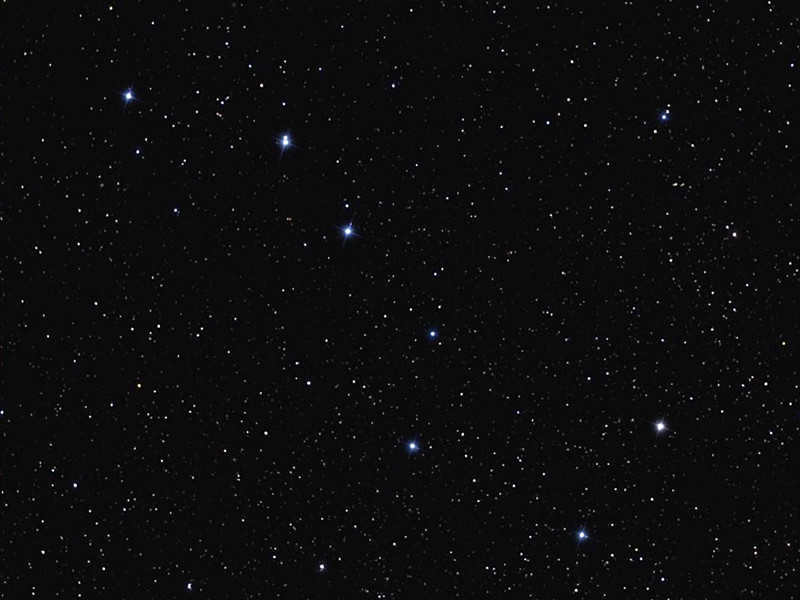
The constellation of the Big Dipper, consisting of seven stars, is incredibly popular for its navigational utility. No other constellation makes it as easy to locate Polaris and determine the direction of the north. Additionally, the image of the Bear holds a certain sacred significance, although not everyone is familiar with the legend associated with this constellation.
It is also known as the “Big Dipper,” perhaps suggesting the existence of a “Small Dipper” and subtly alluding to the constellation of the Little Bear. However, there are larger constellations resembling buckets in the sky, so it is not essential to be well-acquainted with the Little Bear.
Each star in the dipper possesses its own name and is designated by a Greek letter.
α (alpha) is known as Dubhe.
β is referred to as Merak.
γ (gamma) goes by the name of Thekda (Fad).
δ (delta) is commonly known as Megretz.
ε (epsilon) is called Aliot.
ζ (zeta) is known as Mitzar.
η (eta) is commonly referred to as Benetnash (Alkaid).
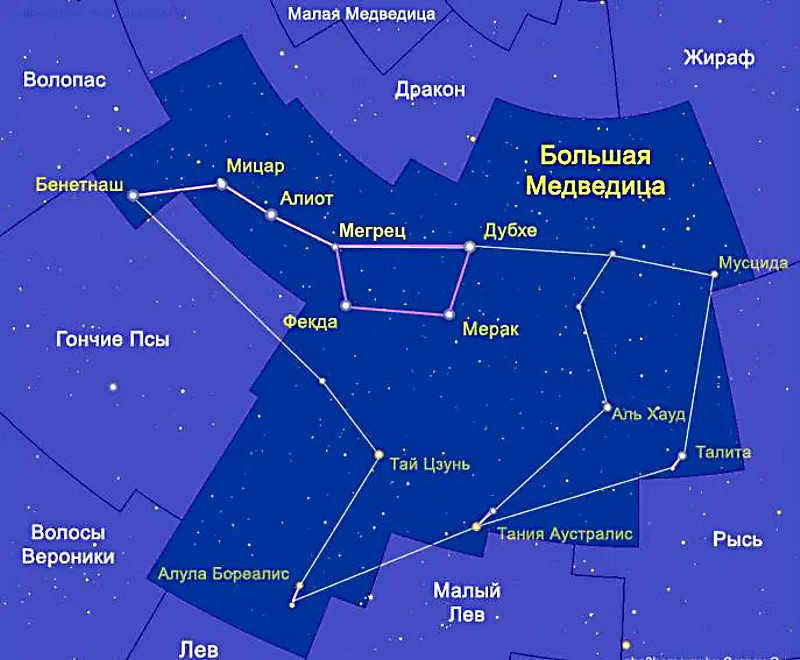
The seven stars forming the Big Dipper are just a fraction of the entire Ursa Major constellation. These stars represent the torso and tail, while there are also the head, front paws, hind paws, and spaces in between, making it a significantly larger constellation. In fact, Ursa Major is the third largest constellation in the sky. It encompasses a total of 126 stars that can be seen without any aid, although to accurately count them, one should venture far away from any sources of light pollution.
So, let’s talk a bit about constellations in general
The majority of stars that are grouped together in what we call “constellations” in the sky are actually not connected to each other in any way. This is due to our unique imagination, which may be unmatched by any other creature in the entire Universe. If we were to explain constellations to beings of equal intellect, mentioning that these three stars form Orion’s belt, and these four form the square of Pegasus – a mythical winged horse that doesn’t exist in reality – we would likely appear strange, if not foolish. There is no scientific basis for this. Furthermore, we sometimes combine stars in a single constellation that are separated by just a dozen or two light years, while others may be separated by many thousands… and there might even be some that no longer exist in reality – they died long ago, but we haven’t yet observed their demise.
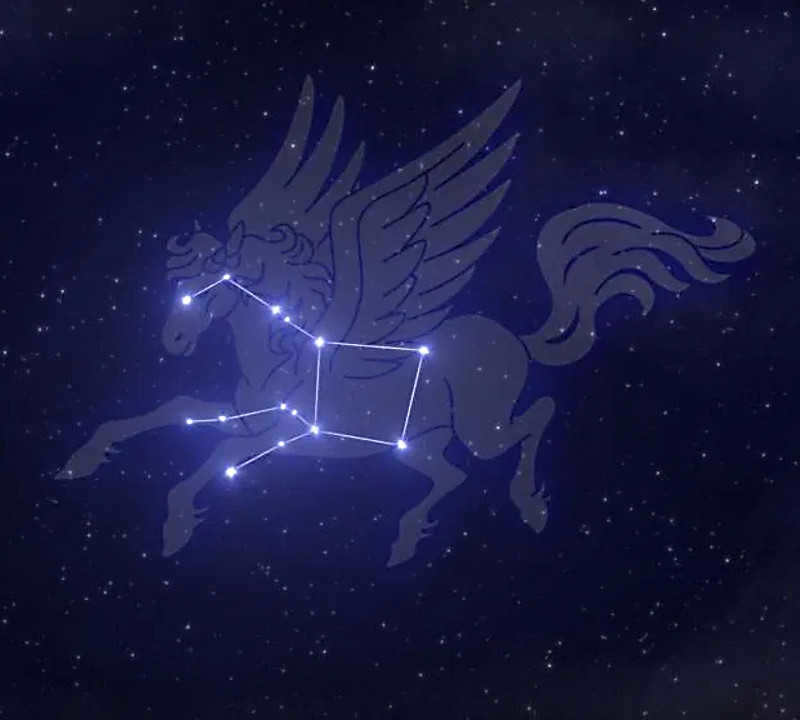
That is the statement that is sometimes made, while pointing towards the constellation of the Big Dipper. Today, I was told the same thing – these stars may appear close to each other in the sky, but in reality, they are at different distances from each other. Some stars are light years away, while others are “millions of light years” away.
I may have missed the part about the “millions” (as there are no stars visible to the naked eye that are millions of light years away), but I agree with the rest. So, I decided to investigate this matter.
Now, let’s direct our attention to the most well-known spot on the handle of the ladle – at the curve where a very bright star known as Mitzar (horse) glistens, and right beside it, a noticeably dimmer star – Alkor (rider). In ancient times, the Arabs would not accept men into the archery profession unless they could individually distinguish these two stars. What was the reasoning behind this? – It was simply because they were only useful for shooting arrows. However, even in the present day, the ability to clearly perceive the small Alcor alongside the radiant Mitzar is considered a testament to one’s exceptional eyesight.

The angular separation between these stars is 12 minutes of arc, which is slightly less than half the size of the Moon. However, it may appear subjectively that the stars are close together, and some may even appear to merge into one. For astronomers, this is considered significant. The typical distance between components of a double system is measured in seconds and fractions of seconds of arc, which is two or three orders of magnitude smaller. At such small distances, there is a possibility that these stars are gravitationally bound and orbit each other in a synchronized dance. Astronomers do not classify stars like Mizar and Alcor as double stars; instead, they are referred to as wide pairs. In the majority of cases, these pairs are optical and not physically connected.
Let’s examine their predicament
The more radiant Mizar is situated 78 light years away. The fainter Alcor, on the other hand, is positioned 81 light years away. Taking into account their overlapping direction, it becomes evident that these two stars are separated by a distance of 3 light years.
That’s quite a considerable gap! Especially for a binary star!
Interestingly, the Russian Wikipedia claims that the distance between them is ten times smaller – only 0.3 light years. However, both sources agree on the fundamental reference points of 78 and 81 light years. Let’s consider the worst-case scenario for the sake of honesty.
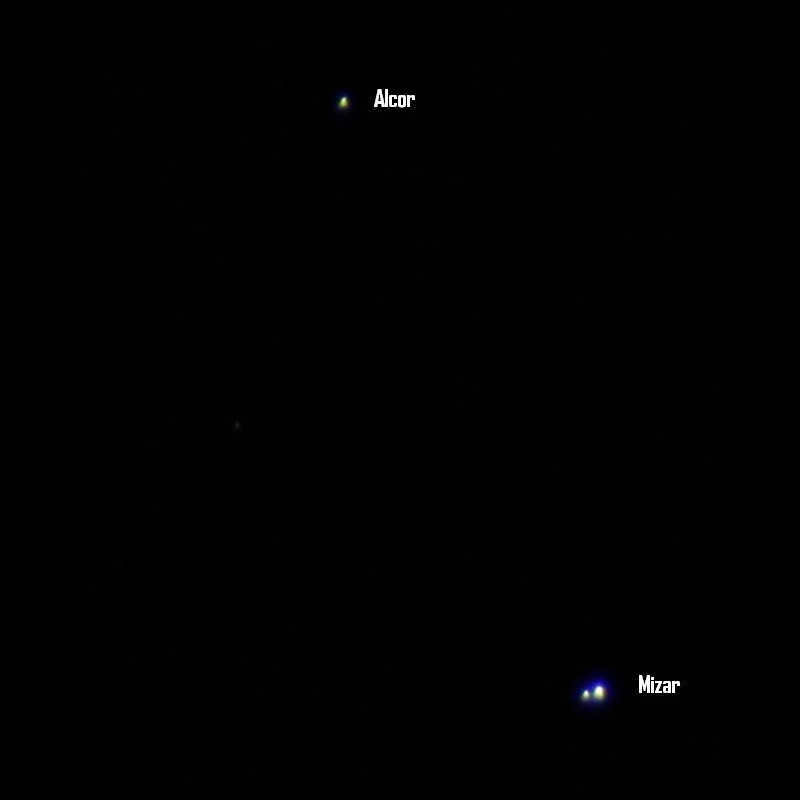
Is it possible for two stars separated by a distance of 3 light-years to be gravitationally bound?
The answer to that question depends on the masses of the stars in question.
For example, the Sun and the Alpha Centauri triple system are separated by a slightly larger distance of 4.4 light-years, and they are not considered to be physically connected. However, these are both low-mass stars. The gravitational influence of the Sun is limited to a sphere with a radius of 1 light-year – this is just a rough estimate, but it can serve as a useful benchmark.
So, what do we know about the masses of Alcor and Mizar?
When we mention these two names, we are not referring to just two stars, but rather six stars in total. Alcor itself is a binary star system, while Mizar is even more interesting as it is a quadruple star system that can be easily observed and split into two using a small telescope. What we find particularly fascinating about this stellar system is its total mass.
Each of the four components of the Mizar multiple star system has a mass that is twice that of the Sun, while Alcor and its companion have a combined mass of more than two solar masses.
In total, this star system has a mass that is ten times greater than that of the Sun. The characteristic radius of gravitational influence can be calculated using the square root of the mass ratio.
The square root of ten is greater than three.
It appears that despite being 3 light years apart, Mizar and Alcor must have a physical interaction. This is evidenced by their coinciding directions of motion in space – Mizar and Alcor fly parallel to each other, neither flying away nor falling behind.
How uncommon is this situation?
Not a common occurrence. Take a look at the nearby star, Aliot (epsilon of the Great Bear) – it also has a dim star next to it – 78 UMa. It’s not as close as Alcor and Mizar – there’s a distance of 1 degree between them, which is five times greater. However, the interesting thing is that this pair is arranged differently in space, and Eliot’s faint companion (unfortunately without a name) is not positioned three light years away, but rather on the same plane. As a result, these two stars are separated by a distance of less than one and a half light-years. Additionally, they are likely gravitationally bound. The combined mass of this system supports that possibility.
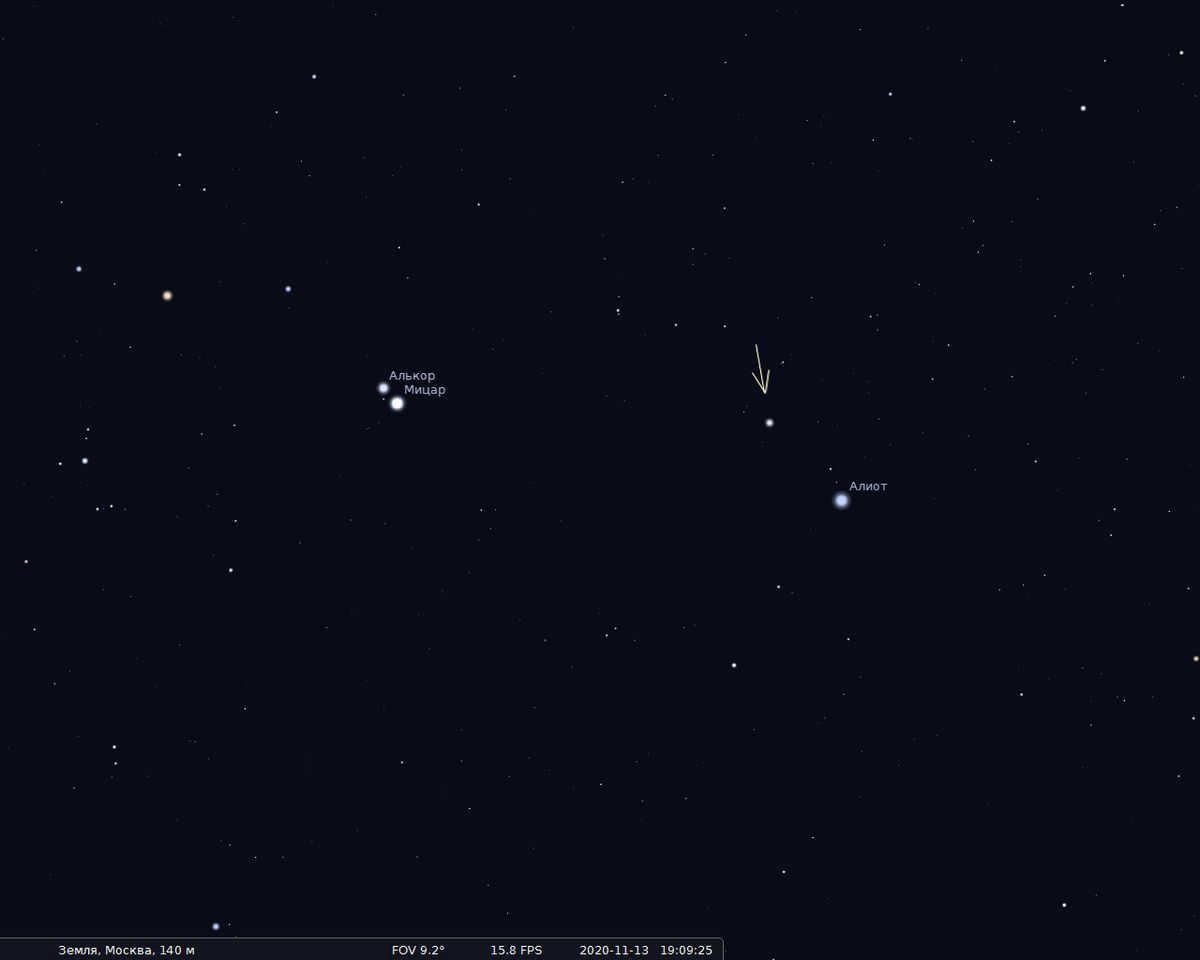
However, what about the other stars in the bucket?
That’s where we come to the most intriguing aspect. The majority of the stars in this constellation (excluding those on the outer edges) are positioned at the same distance from us. When observed on the celestial sphere, they appear as a two-dimensional outline of a bucket, but in reality, they are arranged in three-dimensional space as if they were sketched on a flat surface.
This is a remarkable instance where a cluster of stars maintains its shape regardless of the viewing angle. Even if you were to observe it from the opposite side, it would simply be a mirror image of itself – still resembling a bucket.
Out of the seven prominent stars in the Big Dipper’s bucket, five of them are approximately 80 light-years away. Only Dubhe and Benetnash are slightly more distant, at 123 and 100 light-years respectively, which is not significantly different on an interstellar scale.
The stars in the Big Dipper are not only evenly spaced from the Sun, but they also possess similar physical attributes – they have the same age and chemical composition, comparable masses and luminosities, and most intriguingly, they travel together in the same direction as a cohesive unit.
When we observe the constellation known as the Big Dipper, we are actually gazing upon a vast star cluster that spans over half of the constellation. This cluster consists of stars that were born in the same area of space approximately 300 million years ago and are now traversing the Galaxy together. The majority of the stars in the Big Dipper are siblings. In addition to the prominent stars in the handle of the celestial object, some stars in the head and paws of the constellation also participate in this synchronized journey.
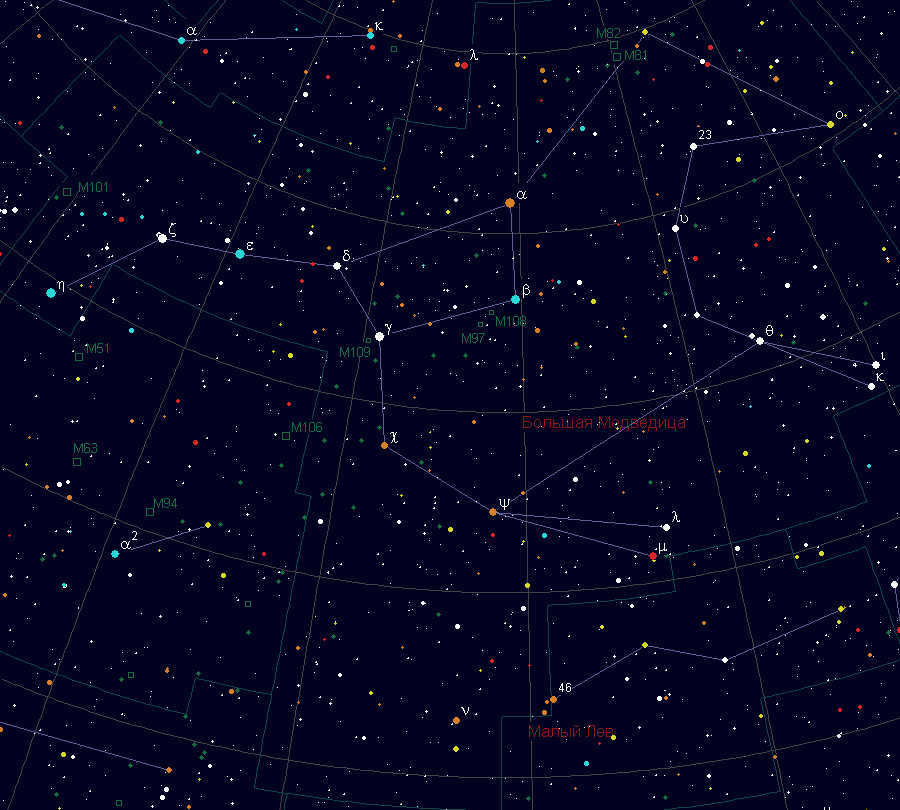
There exist celestial bodies, the arrangement of which in the expanse of the cosmos presents a delicate cosmic joke.
Let us once more observe Mizar and Alcor
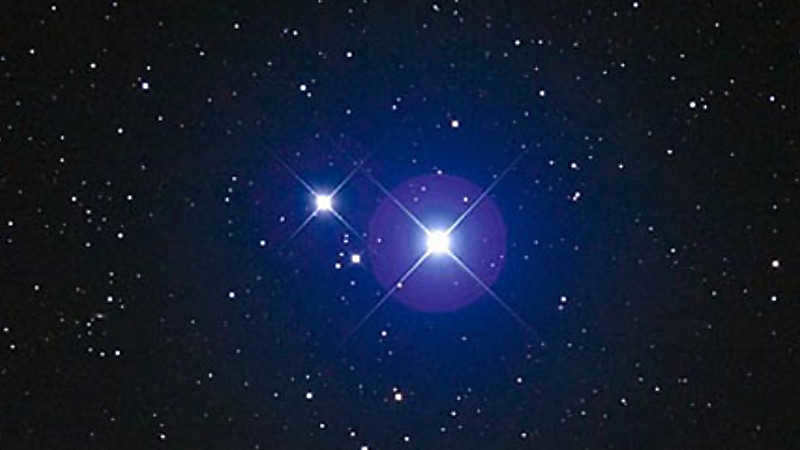
At the conclusion, I present a delightful surprise for all those who have reached this point. A musical composition from my album “Star Bridge” dedicated to the two brilliant stars – Alcor and Mitsar.
The constellation known as the Big Dipper offers a vast array of captivating celestial wonders. In a preceding article, we explored some of the more intriguing stars that can be readily observed with the naked eye or through binoculars/telescopes. However, stars represent only a fraction of the captivating sights to behold within this constellation.
The Big Dipper boasts an extensive assortment of objects, including six from Messier’s catalog – M 81, M 82, M 97, M 101, M 108, and M 109. Among these, M 97 stands out as a nebula, while the others are galaxies. These objects can be easily observed with most amateur telescopes, and some are even detectable with binoculars. However, there exists a multitude of other celestial wonders within this constellation that we shall not delve into at this time.
There are only a few star clusters within the Big Dipper, and even those that do exist are quite sparse in terms of stars and too dim to be observed with small telescopes. As a result, we will not spend much time discussing them.
However, when it comes to nebulae within the Big Dipper, there is one that stands out – M 87, also known as the Owl nebula. This planetary nebula has a circular shape and bears a striking resemblance to the head of an owl, which is how it acquired its name.
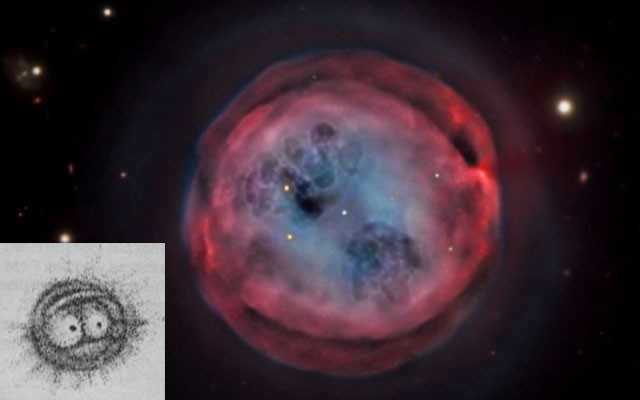
The Owl Nebula. The illustration in the corner was created by Lord Ross, who gave this nebula its name.
Observing the Owl Nebula can be challenging. With a magnitude of 10m, it has a size comparable to five Jupiter disks, and this brightness is spread across the entire area. Therefore, detecting the glow of this nebula requires a telescope with an aperture of 110mm or more.
The Owl Nebula is located near the star Merak (beta) in the vicinity of M 87, and the galaxy M 108 can also be found nearby. Photographs capturing them in the same frame are quite impressive.
Galaxies
There is an astonishing abundance of galaxies within the confines of the Big Dipper constellation. Naturally, there exists a multitude of galaxies in every section of the sky, but this specific region is distanced from the Milky Way, allowing for a clearer view of deep space. The Hubble Space Telescope captured images that revealed the presence of up to 1500 galaxies in a minuscule expanse. Clearly, with our humble telescope from Earth, we are only able to observe a miniscule fraction of this vast array, but we are still able to witness something.
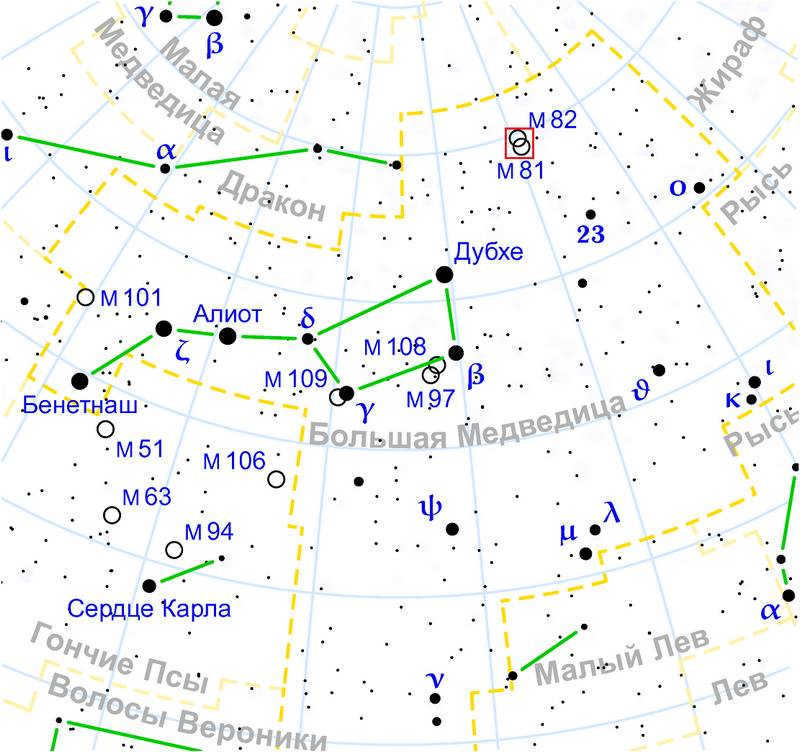
The arrangement of galaxies in the Big Dipper constellation.
The cluster of galaxies M 81 and M 82
Two galaxies, M 81 and M 82, are situated in close proximity to one another – in the night sky, the distance separating them is approximately equal to the diameter of the Moon. Consequently, when observed through a telescope or even with sufficiently powerful binoculars equipped with a lens measuring 70 mm or above, they can be seen within the same field of vision. This amalgamation of galaxies is regarded as one of the most visually striking in the entirety of the northern hemisphere’s night sky.
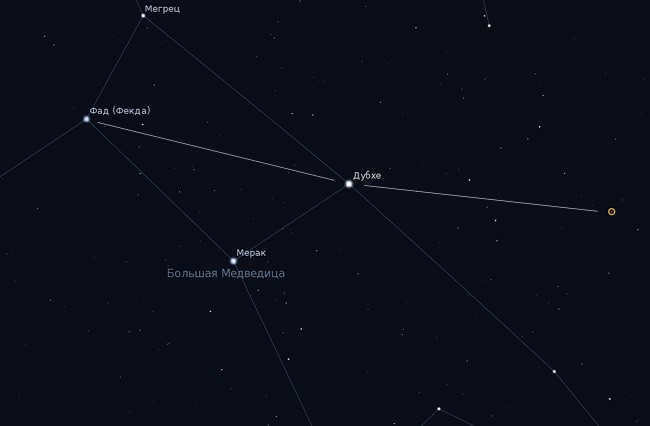
If you want to locate M81 and M82, you can utilize the stars of the Ursa Major constellation.
M81 is a typical spiral galaxy that is oriented towards us at a slight angle, making it relatively bright – it can be observed with 50-mm binoculars. It is also known as the Bode galaxy, as it was discovered by astronomer Johann Bode in 1774.
M82 has an elongated shape, earning it the nickname “Cigar.” It is an irregular galaxy. Approximately one and a half million years ago, a massive explosion occurred at its core, resulting in the wispy structures visible in photographs. These structures consist of gas clouds moving at speeds exceeding 1,000 kilometers per second.
The two galaxies are held together by gravity and are members of the M 81 group of galaxies, which includes around thirty other galaxies. This cluster is located approximately 11 to 12 million light years away from our position and is the nearest group of galaxies.
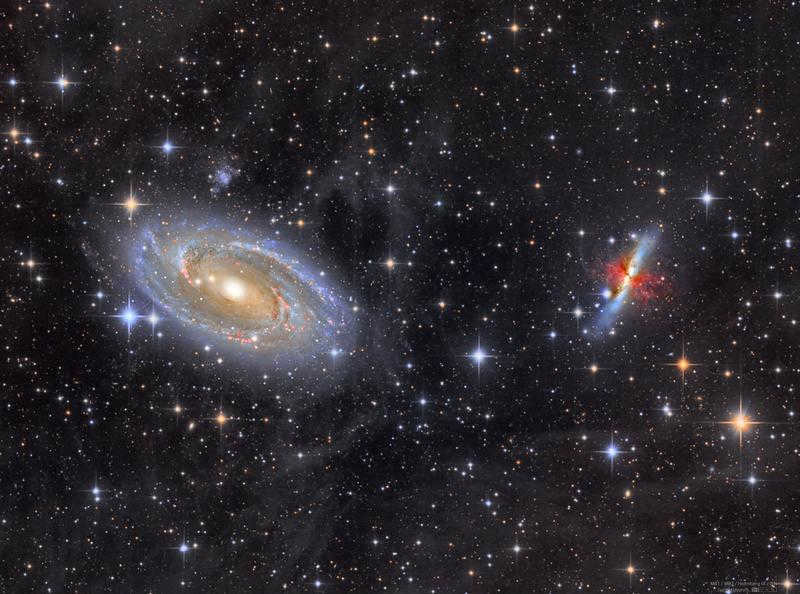
M81 appears as a blurry oval shape with a brightness of 6.94m when observed through a small telescope or binoculars. Interestingly, some individuals with exceptional eyesight have been able to spot this galaxy in the sky even without the aid of binoculars, making it one of the most distant objects in the Universe visible to the naked eye. To observe its spiral structure, a powerful telescope with an aperture of 200 mm or more is required.
The uneven brightness of its edges allows for the differentiation of the structure of M82 in a telescope with an aperture of 100 mm or larger.
Galaxy M 101.
This particular galaxy, in addition to the Andromeda Nebula and the Triangle Galaxy, is widely recognized and known. Its images are extremely breathtaking, captivating the attention of countless individuals. When one wishes to showcase a galaxy in all its grandeur, there is simply no better choice. Here, one can find resplendent spiral arms, as well as clusters of interstellar gas, all exuding a radiant, pristine, and exquisite aura. This galaxy has been aptly named Spiral due to its striking resemblance to an awe-inspiring fireworks display.
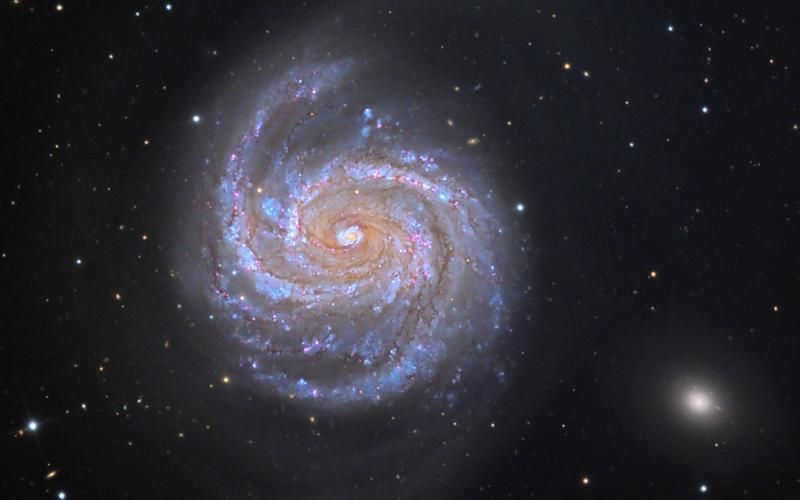
Nevertheless, a small amateur telescope cannot capture such a breathtaking sight. Despite having a sky brightness of 7.7m, the surface brightness of M 101 is 14.8m, necessitating a high-quality telescope with a large aperture to observe anything within it.
With a telescope or binoculars featuring a 70 mm objective lens, you will only be able to perceive a hazy cloud, and even then, ideal conditions are required – a clear sky devoid of light pollution. M 101 boasts an angular size comparable to that of the full Moon, but locating this galaxy is no easy task. It is advisable to use peripheral vision or slowly move the telescope or binoculars – this galaxy becomes more noticeable in motion. The details within its spiral arms become discernible with a telescope with a diameter of 250 mm or greater.
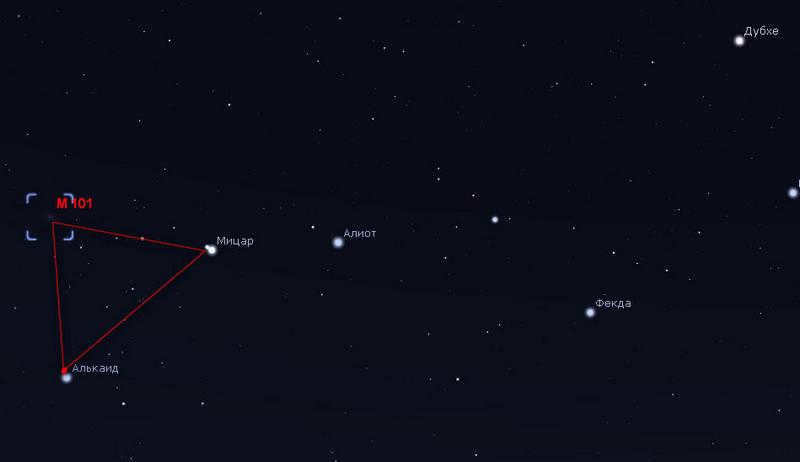
The position of M101 in the night sky can be visualized as forming an equilateral triangle with the outermost stars of the Big Dipper constellation.
This galaxy is situated at a staggering distance of 27 million light years away from our planet, and it is of immense proportions. With a diameter of 170,000 light years, M101 is 1.5 times larger than the Milky Way, our own galaxy.
Galaxy M 108
The galaxy M 108 is situated in close proximity to the star Merak. With a luminosity of 10.1m and a surface brightness of 13m, this galaxy requires a fairly powerful telescope for observation. Under optimal conditions, a telescope with a 100 mm aperture will enable you to detect the galaxy’s disk, while a 150 mm aperture will reveal some of its structural details.
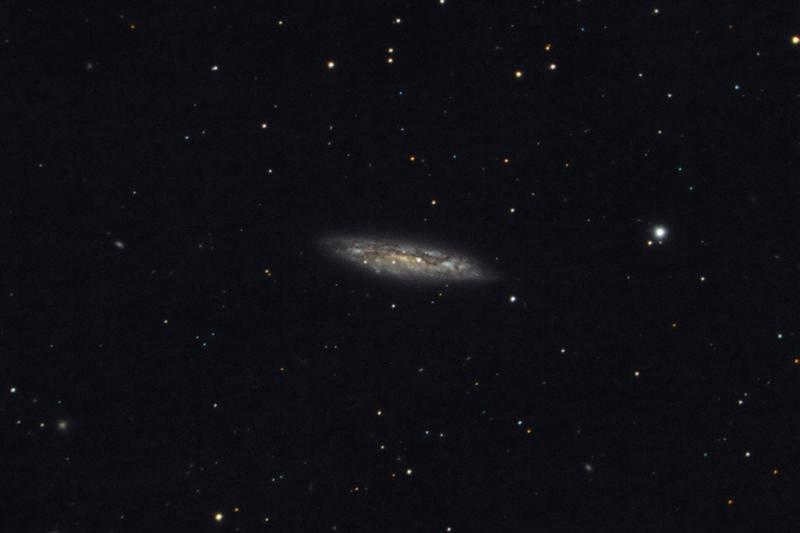
This particular celestial body is classified as a spiral galaxy; however, its orientation in relation to us is such that we observe it from its edge. Within the galactic plane, there exist dense clouds of dust, obstructing our view of its core. Consequently, the galaxy appears dimmer than it truly is. If the galaxy were to undergo a slight rotation, its luminosity would be significantly enhanced.
The luminosity of this massive spiral galaxy is 9.8m, while its surface brightness measures 13.5m. Consequently, the intricate details of its structure remain hidden from view when observed through small telescopes. However, the nucleus and the junction, which emit a significant amount of light, can still be discerned. For a more comprehensive view, it is recommended to use a telescope with an aperture of 150 mm or greater.
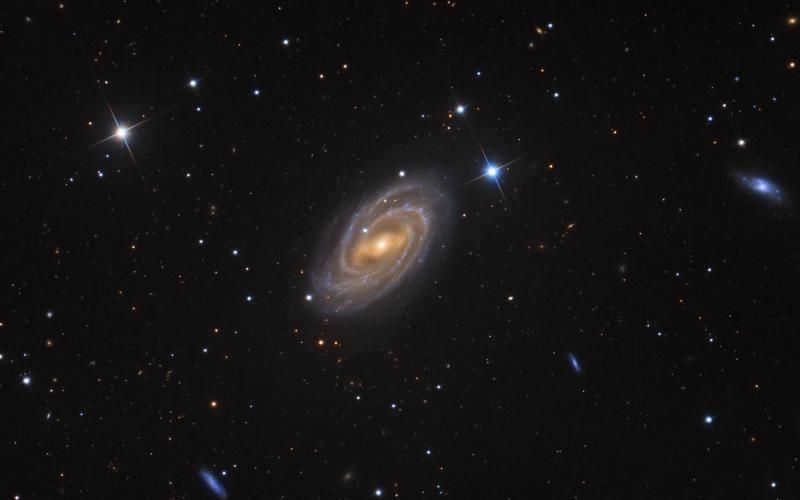
It is effortless to locate Galaxy M109 as it is situated close to the star Fekda. Nevertheless, the star’s intense brightness can hinder observations. Furthermore, at times, the glare on the optics caused by the star is mistaken for a galaxy.

In the northern hemisphere of the sky, you can find the constellation known as the Big Dipper. This constellation is made up of seven bright stars that create a pattern resembling a bucket with a handle. Most people are familiar with The Big Dipper and have likely heard of it before.
The Big Dipper is considered an asterism, which is a group of stars that has a recognized name of its own.
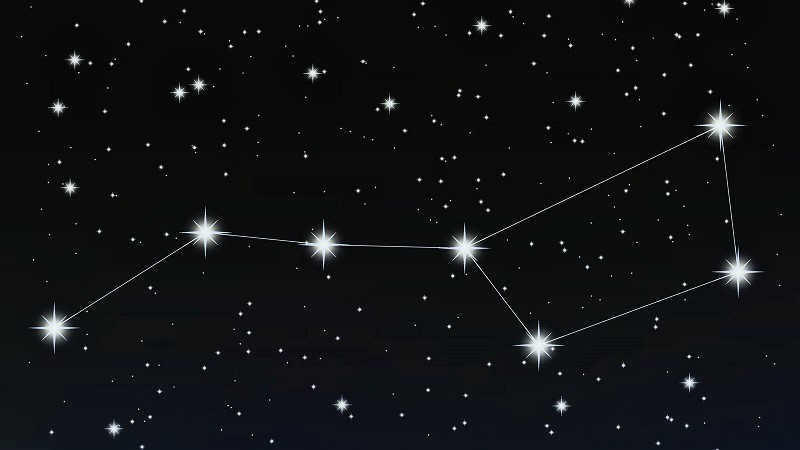
It turns out that the five stars within the Big Dipper form a single moving group. Their motion is actually quite fast. However, Dubhe and Benetnash move in opposite directions, causing a change in the shape of the entire constellation.
Additionally, Merak and Dubhe are often referred to as pointers because if you draw a straight line between them, it will point towards Polaris. Furthermore, they create the wall of the Big Dipper.
Moreover, Mizar, Aliot, and Benetnash form an arc that points directly towards the brightest star visible in the spring, Arcturus. If you extend this arc towards the south, it will lead you to Spica, which happens to be the brightest star in the Virgo constellation.
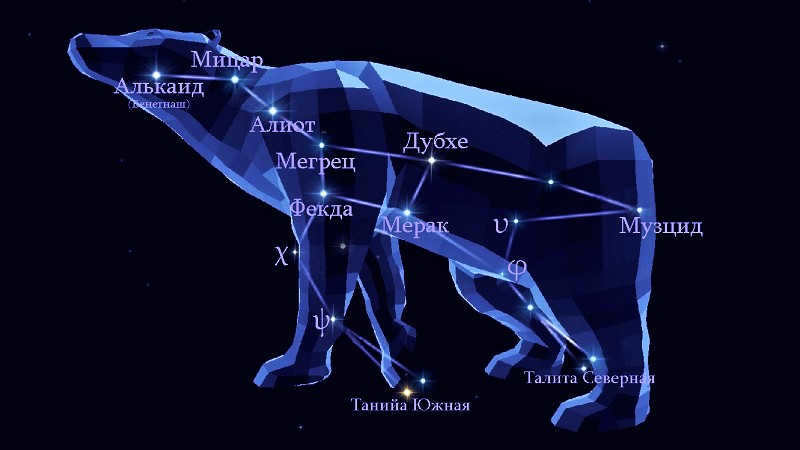
What constitutes the Big Dipper
Surprisingly, the stars have Arabic names, but their classifications are Greek.
Epsilon is the brightest star in the constellation. It is called Aliot, which roughly translates to curd.
Alpha is known as Dubhe and is a spectroscopic star.
Beta Merak is a celestial luminary in the main sequence.
This is the composition of the Big Dipper. Alcaide is a young star in the main sequence. Interestingly, it is also known as Benetnash. There is no exact translation for this name, but it is often referred to as the leader of the mourners.
Gamma of the constellation Fekda (hip) also belongs to the main sequence. It has a gas shell, as emission lines can be observed in its spectrum.
Delta – Megrez is known as the start of the tail. It is the dimmest of the seven stars in terms of luminosity. However, it is also classified as a main sequence star.
Zeta – Mizar, also referred to as the middle of the Bucket, is a binary star system. Astronomers have noted that it was the first of its kind to be captured in a photograph.
In addition to everything in the expanse of the specified area, numerous Messier objects have been discovered
These encompass spiral systems:
- The Bode Galaxy, also known as M81.
- The Cigar Galaxy, also known as M82 – a galaxy characterized by its rapid star formation. In the infrared spectrum, it stands out as one of the brightest in this cluster.
- The Spinner, also known as M101, a galaxy that dwarfs the Milky Way in size.
- M108 with a junction, along with a similar spiral galaxy featuring a junction, M109.
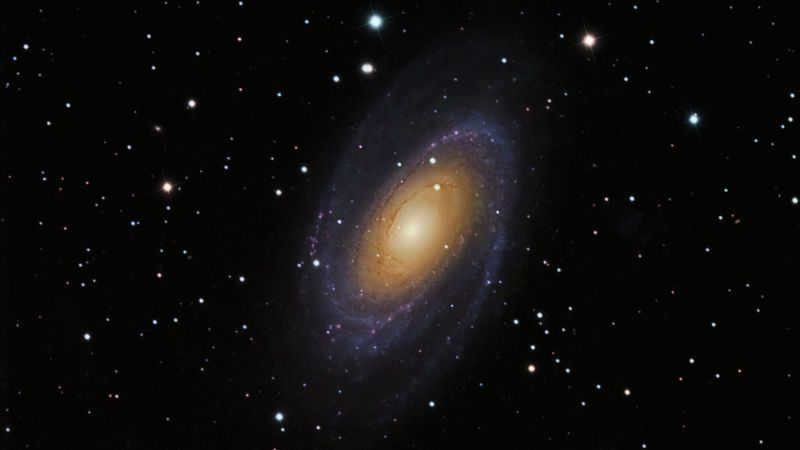
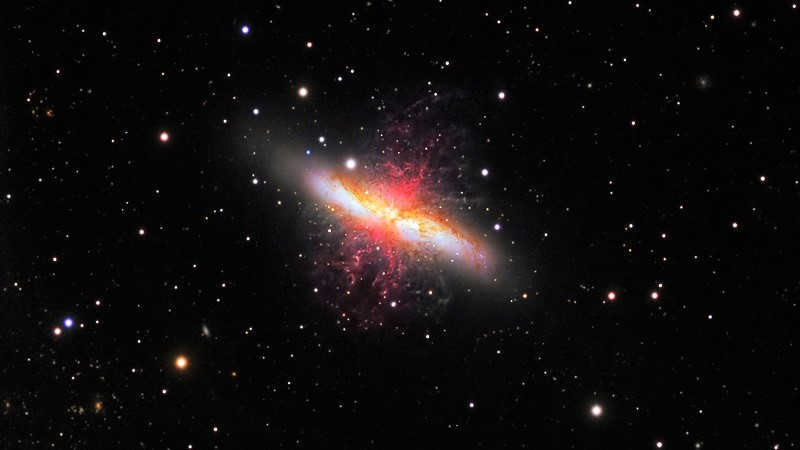

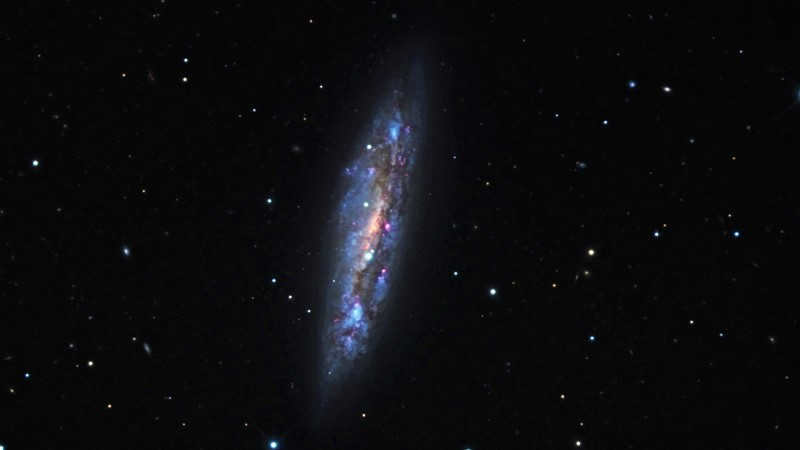
- NGC 5474 is a system of dwarf galaxies that exhibit spiral characteristics.
- The Owl Nebula, also known as M97, is a planetary nebula.
- Messier 40, or M40, is a double star.
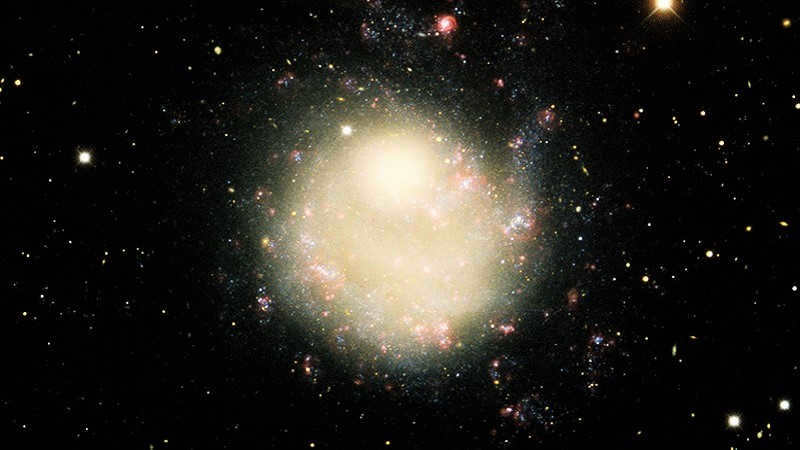
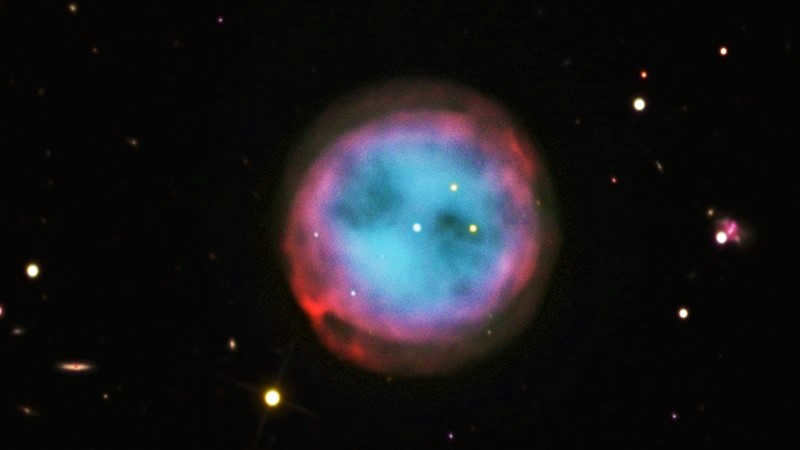
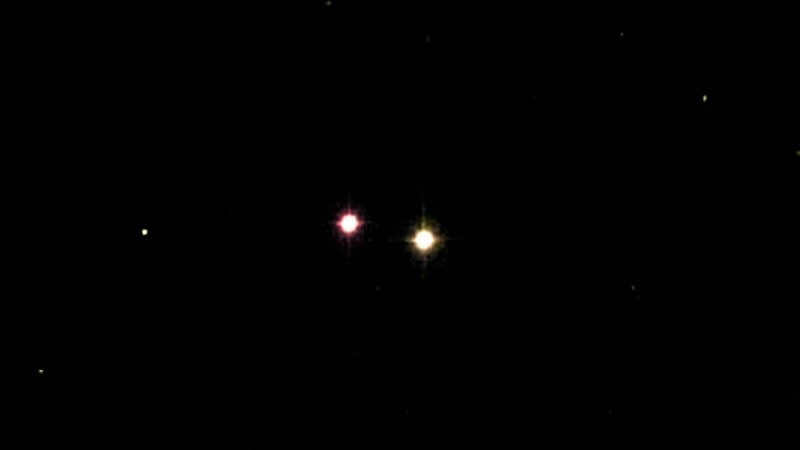
Three bounds of a gazelle
This is actually another group of stars in the sky that belongs to the constellation of the Big Dipper. It consists of three pairs of bright stars that resemble the leaps of a gazelle.
The first bound
The stars Nu and Xi in the Big Dipper are known as the Shark of the North and the Shark of the South, respectively. The former is a double giant, while the latter is a star system consisting of main-sequence dwarfs.
In the vicinity of the North Shark, there is a red dwarf star called Laland 21185 that emits X-rays. Interestingly, this star system is one of the closest to us.
Surprisingly, the stars Xi have similar spectral characteristics and each of them has a low-mass companion. Notably, the Southern Shark was the first double star to have its orbit accurately calculated.
The next leap
Lambda or Tanias of the North, a celestial body undergoing a transformation into a colossal entity.
Mu or Tanias South has already reached giant status. Additionally, it is classified as a red star and is accompanied by a companion.
The fourth jump
Iota (Talitha North) is a binary star system. It consists of a subgiant star and two stars with magnitudes of 9th and 10th.
Kappa (Talitha South) is a binary system composed of dwarf stars in the main sequence.
Additional Items
47 is a star that is similar to the Sun and is located between the first and second “gazelle jump”. In 2015, it was named Chalavan.
Omicron – Muscida is a system of multiple stars, consisting of three or possibly more luminaries.
Groombridge 1830 is a subdwarf star that belongs to a group of halo stars that have a direction opposite to the rotation of the galaxy.
Alcor is a stellar companion known as Mitsara. They are often referred to as the Horse and the Rider.
W of the Big Dipper is an eclipsing variable system with two closely located stars that are in contact with each other.
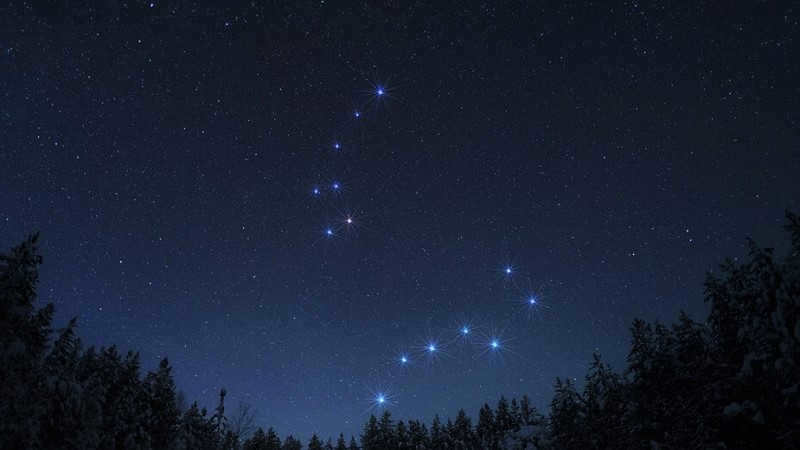
The Big and Little Dipper constellations have been familiar to mankind for millennia. The origins of their appearance are steeped in intriguing history and numerous legends.
The Big Dipper covers an area of 1280 square degrees, making it the third largest constellation, as mentioned earlier.
Adjacent to it are several other well-known sections of the sky, including Volopassus, Veronica’s Hair, the Giraffe, and the Dragon. Lynx, Hound Dogs, Leo, and Little Leo are also neighbors of the Big Dipper.
The optimal time for observing these constellations is during March and April. Fortunately for Russian enthusiasts, the Big Dipper can be seen throughout the country. However, in the autumn, it descends closer to the horizon, becoming hidden from observers.
Not many people are aware that the constellation has numerous names: Plow, Wagon, Elk, Seven Wise Men, and others. The name that is more familiar to us, and also official, is the Big Dipper.
Because it is made up of the seven brightest stars, the shapes formed by them can be interpreted in various ways.
Due to its location and distinctive brightness, the constellation is one of the well-known and easily recognizable ones in the night sky.
However, there are numerous theories regarding the origin of the Big Dipper constellation. It can be said that each nation has its own separate history associated with it.
The Big Dipper constellation The Big Dipper constellation
India
India is a country located in South Asia.
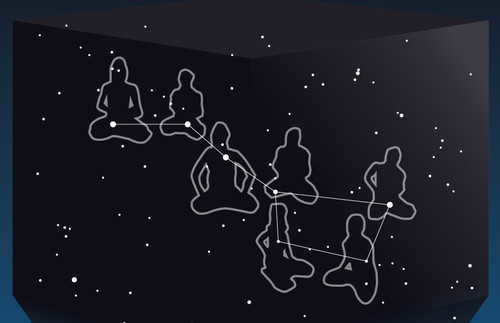
Ancient Indian observational astronomy did not reach the same level of advancement as mathematics. Its concepts were heavily influenced by both Greece and China. For instance, the 27-28 “stands” (nakshatras) that the Moon passes through in about a month bear a striking resemblance to the Chinese lunar “houses”. Hindus also held great significance to Polaris, which the Vedas experts believed to be the dwelling place of Vishnu himself. The Bucket asterism located below it was known as Saptarisha, representing the seven sages who were born from Brahma’s mind and are considered the ancestors of our current era (Kali-yuga) and all living beings in it.
Let’s examine the seven most brilliant stars of the Big Dipper in a descending order based on their visual stellar magnitude:
Aliot (Epsilon of the Big Dipper).
Aliot is an extraordinary blue-white star that falls under the category of subgiants. It is situated relatively close to us, at a distance of merely 81 light-years. With a visual magnitude of 1.75, this star shines brightly in the night sky. Aliot is approximately four times more massive than our Sun and has a diameter twice as large. Its luminosity surpasses that of the Sun by about 127 times.
Dubhe.
Dubhe is located 124 light-years away and is classified as an orange giant. It has an apparent stellar magnitude of 1.81, making it approximately 415 times brighter than our Sun. Interestingly, Dubhe is not a single star but a double star system, with its two members orbiting each other every 44.4 years.
Benetnash.
Benetnash, on the other hand, is a blue-white star that belongs to the main sequence. It is situated at a distance of approximately 100 light-years from the Sun. With a visual stellar magnitude of 1.85, Benetnash shines brightly in the night sky. In terms of mass, it is about six times heavier than our Sun and a staggering 700 times brighter.
Mizar and Alcor (Zeta of the Big Dipper/80 of the Big Dipper)
These two celestial bodies are perhaps the most renowned binary stars visible to the naked eye in our sky. They are also referred to as the Horse and Rider. Both objects are white stars located approximately 80 light years away from our planet. Mizar possesses a brightness of 2.23 magnitudes, while Alcor shines with a magnitude of 4.01. These stars appear to be in close proximity to each other, which led ancient civilizations such as the Persians, Romans, and Arabs to employ their separation as a test for aspiring archers.
Merak.
Merak is a brilliant white star located approximately 79 light years away from Earth. It has a stellar magnitude of 2.34 and is about three times larger and more massive than our Sun. Merak emits a dazzling light that is 70 times brighter than our Sun.
Fekda (Gamma of the Big Dipper).
Fekda, also known as Gamma of the Big Dipper, is another captivating white star in the main sequence. It is located at a distance of 84 light-years from our planet. With an apparent stellar magnitude of 2.43, Fekda shines approximately 71 times brighter than the Sun.
Megrez (Delta of the Big Dipper).
A star that shines with a blue-white hue, Megrez (also known as Delta of the Big Dipper) is located relatively close to our solar system, only about 58.4 light-years away. With an apparent stellar magnitude of 3.312, it is easily visible to the naked eye. Not only is this star visually striking, but it is also more massive than our sun, weighing in at approximately 63% more. Additionally, Megrez is an impressive 14 times brighter than our sun.
China
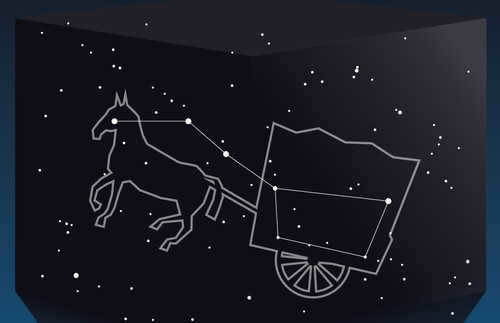
Ancient Chinese astronomers had a unique way of dividing the sky into 28 vertical sectors, known as “houses”. These houses correspond to the Moon’s monthly journey, similar to how the Sun passes through the signs of the Zodiac in Western astrology. The concept of the 12-sector division in Western astrology was actually borrowed from the Egyptians. In the center of the sky, like an emperor in the capital, the Chinese recognized Polaris, which had already taken its rightful place. The seven brightest stars of the Big Dipper are also in close proximity to Polaris, within the Purple Enclosure. This enclosure is one of three that surround the palace of the “royal” star. These stars can be described as the Northern Ladle, as their orientation corresponds to the seasons, or as part of the carriage of the Heavenly Emperor Shandi.
Asterism of the Ursa Major
The Ursa Major is the third largest constellation, covering 3.1% of the night sky. It is easily identifiable, as mentioned earlier. The seven prominent stars that form the Ursa Major create an asterism known as the Big Dipper, which is also referred to as the “Plow” or “Frying Pan”. The arrangement of four stars resembles the shape of a dipper, while the remaining three stars represent its handle. Some people mistakenly believe that the seven stars constitute the entire Ursa Major constellation, but this is incorrect. They only account for less than half of it.
The asterism of the Ursa Major can be observed in the night sky, as reported by various sources. The depiction of the Ursa Major asterism in the night sky is available from both public and open sources.
Similar Sign
The numerous stars scattered throughout the vast expanse of the dark sky may appear to be countless, but in reality, the naked eye can only perceive around 6000 distant luminaries. However, even among these stars, navigation can be quite challenging. Throughout history, astronomers from various cultures have created constellations based on their own legends, beliefs, and interpretations of the world. These same constellations, which are comprised of groups of bright stars known as asterisms, have been associated with various objects and beings. For instance, the well-known Big Dipper in the constellation Ursa Major has often been linked to objects and creatures that bear no resemblance to either a dipper or a bear.
Greece
– Greece is a country located in southeastern Europe, known for its rich history and stunning landscapes.
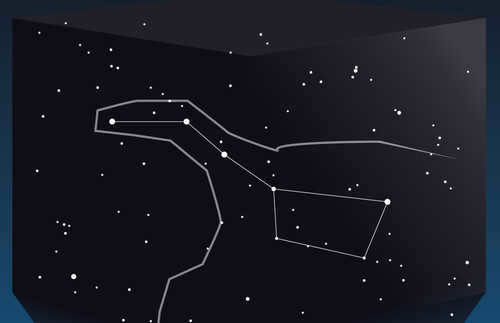
The constellation known as the Big Dipper is part of a group of 48 constellations that were first cataloged by Ptolemy around 140 BC. However, references to the Big Dipper can be found even earlier, dating back to the time of Homer. In Greek mythology, there are various stories that explain the origin of the Big Dipper, but they all revolve around the bear who is actually the beautiful Callisto, the companion of the goddess Artemis. According to one version of the story, Zeus, in his usual amorous ways, seduced Callisto, which angered his wife Hera and Artemis herself. To protect Callisto, Zeus transformed her into a bear, and she wandered in the mountains for many years until her own son, who was fathered by Zeus, found her during a hunt. Zeus had to intervene once again to prevent the murder of his own offspring, so he brought both Callisto and her son to live among the stars in the heavens.
The word arktos comes from Greek and means bear. That is why the name Arctic, which means “bear,” is given to the northernmost region of the Earth. It is in this region that we can see the constellation known as the Big Dipper most clearly. Many of us have probably observed this constellation in the night sky numerous times. It is easy to spot, even for someone with limited knowledge of astronomy, on a clear night. The Big Dipper, along with its neighboring constellation, the Little Dipper, can be seen from Earth as far south as 30 degrees latitude. Both constellations are located near the poles, so they are visible year-round in the northern hemisphere.
Related signs
Do you remember the heartwarming and nostalgic Soviet animated film featuring Umka, the adorable polar bear cub? And the sweet lullaby his mother sang to him? The lyrics went like this: “. and all night long the neighboring star bears illuminate distant ships . “. But what exactly are these star bears? They refer to the constellations of Ursa Minor, also known as the Little Bear, and Ursa Major, which Ilya Lagutenko from the band Mumiy Troll occasionally observes.
Therefore, the focus of today’s article is the Ursa Major constellation, more commonly known as the Big Dipper.
Egypt
can be paraphrased as
The Land of the Pyramids
.
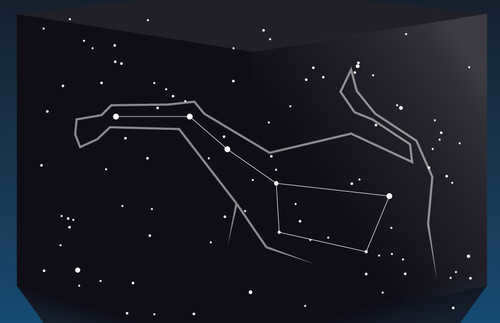
A similar omen
The Big Dipper is a constellation located in the northern hemisphere. It is the third largest constellation in the celestial sphere. This constellation is famous for its distinct pattern of seven stars, forming the shape of a “Big Dipper” or Great Bear. The well-known group of stars in the night sky includes Dubhe, Merak, Feqda, Megrez, Aliot, Mitzar, and Benetnash (Arabic for Alqaid). The Big Dipper was initially documented by the Greek astronomer Ptolemy in the 2nd century, and it remains one of the most easily identifiable constellations.
Interesting facts about the Big Dipper constellation
The Big Dipper constellation is home to seven celestial objects in deep space. These objects include Messier 40 (M40), Messier 81 (M81 or NGC 3031), Messier 82 (M82 or NGC 3034), Messier 97 (M97 or NGC 3587), Messier 101 (M-101 or NGC 5457), Messier 108 (M108 or NGC 3556), and Messier 109 (M109 or NGC 3992). Additionally, it is known to host a total of 13 stars that have confirmed exoplanets.
The Legends and Myths Surrounding the Big Dipper Constellation
The constellation has its origins in Greek mythology. Callisto, a stunning woman, was the companion of Artemis, the goddess of hunting. Despite taking a vow of celibacy, Zeus, the god, took notice of her and deceived her into breaking her vow. Consequently, she became pregnant and was exiled by Artemis to the wild, where she gave birth to her son Arcas. Upon learning of her husband’s infidelity, Hera, Zeus’ wife, grew enraged and transformed poor Callisto into a bear. For many years, she dwelled alone in the wilderness. One fateful day, she encountered her long-lost son, who, unaware that the bear was his mother, was on the verge of slaying her. Zeus intervened, summoning a whirlwind that carried them both into the sky. Thus, they became the constellations known as the Big Dipper and the Little Dipper.
The most well-known stars of the Big Dipper are
The star Aliot, also known as ε UMa, is the brightest star in the constellation of the Big Dipper and the 31st brightest star in the night sky. It has an apparent stellar magnitude of 1.76 and is located approximately 81 light years away from Earth. The name “Aliot” comes from the Arabic word Alyat, which translates to “fat tail.” Despite its unusual name, Aliot is situated in the withers of a bear within the constellation.
Aliot was first discovered in 1869 by the English astronomer Richard Proctor and falls under the spectral class A0pCr. It has a surface temperature that is about three times hotter than the Sun, measuring over 15,000 degrees Celsius. Additionally, Aliot is 3.5 times larger in radius compared to the Sun.
Another notable star in the Big Dipper is Dubhe, also known as α UMa.
The Dubhe star, with an apparent magnitude of 1.79, is located 123 light years away. It holds the position as the second brightest star in the Big Dipper constellation. The star’s name originates from the Arabic phrase żahr ad-dubb al-akbar, which translates to “the back of a big bear.”
Dubhe is classified as a giant star within the K1 II-in III spectral class. Additionally, it is a spectroscopic double star, with its companion being a main-sequence star belonging to the F0 V spectral class. These stars revolve around each other every 44.4 years, with a distance of 23 astronomical units between them.
The star Merak, also known as β UMa, is another significant member of the Big Dipper. Its name is derived from the Arabic term Al-maraqq, which means “loins.”
β UMa is categorized as a main sequence star, situated 79.7 light years away. It exhibits a visual apparent magnitude of 2.37 and falls under the A1 B spectral class.
β of the Big Dipper weighs 2.7 times more than the Sun. Merak has a radius 2.84 times larger and is approximately 68 times more luminous than our Sun. The surface temperature of the star is around 11,000°C.
The star Benetnash (Alkaid) is η of the Big Dipper (η UMa)
Benetnash is positioned at the easternmost point in the Big Dipper. It is also recognized as Alkaid. In Arabic, al-kaid banat nash translates to “leader of the mourners”. It is a youthful main-sequence star classified as B3. It is situated at a distance of about 101 light-years from us. It has an apparent magnitude of 1.85. η UMa ranks as the third brightest star in the constellation and the 35th brightest star in the night sky.
The star Feqda, also known as γ UMa, belongs to the Big Dipper constellation.
The name Feqda comes from the Arabic word “فخذ” (fakhdh), which means “thigh”.
Feqda is classified as a main-sequence star with a spectral type of A0 Ve. It has a visual magnitude of 2.438 and is located approximately 83.2 light-years away.
Scientists estimate that Feqda is around 300 million years old. Interestingly, it is only 8.55 light-years away from the Mizar-Alcor star system.
Another star in the Big Dipper is Megretz, also known as δ UMa.
Megretz is the faintest among the seven brightest stars in the Bucket asterism. It is classified as a main-sequence star with a spectral type of A3 B. Megretz has an apparent magnitude of 3.312 and is situated about 58.4 light-years away from our solar system.
What makes Megretz intriguing is that it is 14 times brighter than the Sun and 63% more massive. Additionally, it emits an excess of infrared radiation, which suggests the presence of a debris disk in its orbit.
The term “Megrez” comes from the Arabic word Al-maghriz. which translates to “base.”
Mizar’s star is ζ, part of the Big Dipper (ζ UMa)
Mizar is a system made up of two binary stars. The name “Mizar” is derived from the Arabic word mīzar, which means “belt” or “loincloth.”
Mizar has a stellar apparent magnitude of 2.23. It is located approximately 82.8 light-years away from our solar system. This system was the first double star to ever be captured in a photograph. In 1857, American photographer and inventor John Whipple, along with astronomer George Bond, used a plate and a 15-inch telescope at the Harvard College Observatory to capture an image of the binary. Prior to this, they had also photographed the star Vega in 1850.
Deep space objects in the constellation of the Big Dipper
Messier 81 (M81 or NGC 3031)
Messier 81 is a prominent and expansive spiral galaxy positioned approximately 11.8 million light-years distant from our planet.
Due to its relatively close proximity and remarkable luminosity, with an apparent magnitude of 6.94, M81 attracts the attention of both amateur and professional stargazers.
The visible dimensions of this galaxy are measured at 26.9 x 14.1 arc minutes. It was in March 1993 that the supernova star SN 1993J was first detected within its expanse.
This particular galaxy was initially observed by the German astronomer Johann Ehlert Bode in the year 1774. It was later included in Charles Messier’s catalog in 1779.
The Cigar or Messier 82 galaxy (M82 or NGC 3034)
Messier Galaxy 82 can be found approximately 11.5 million light-years away from our solar system. It possesses an apparent magnitude of 8.41.
Star formation in the core of the galaxy is occurring at a rate ten times faster than in the entire Milky Way. M82 shines five times brighter than our own galaxy. In 2005, the Hubble Space Telescope identified 197 massive star clusters in the central region of M82.
Scientists believe that the Cigar galaxy experienced a tidal collision with its neighboring galaxy, Messier 81, resulting in the formation of a large amount of gas in its center over the past 200 million years. As a result, star formation activity in M82 has increased significantly compared to most other galaxies.
M82, along with M81, was first discovered by Johann Ehlert Bode on December 31, 1774. Bode initially described them as hazy spots.
The Owl Nebula, also known as Messier 97 or NGC 3587
The Owl Nebula is a planetary nebula situated approximately 2,600 light-years away from our solar system. It possesses an apparent magnitude of 9.9.
M97 was initially detected by French astronomer Pierre Mechene in 1781. This galaxy is thought to have originated around 8,000 years ago.
The reason behind the name of the Owl Nebula is its striking resemblance to an owl when observed through a powerful telescope.
The United States of America
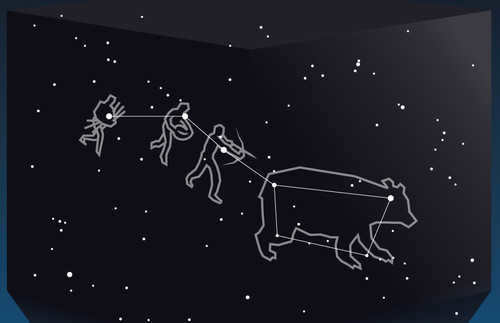
It appears that the Native Americans had some understanding of untamed creatures: in the Iroquois myth surrounding the creation of the constellation, the “celestial bear” lacks a tail. The trio of stars that make up the handle of the dipper represent three hunters in pursuit of the creature: Aliot wields a bow with an arrow firmly lodged within it, Mitzar carries a pot for cooking meat (Alcor), and Benetnash holds a bundle of kindling to ignite the fire. As autumn arrives and the Big Dipper rotates and descends towards the horizon, blood from a wounded bear trickles down, leaving the trees adorned with a patchwork of colors.
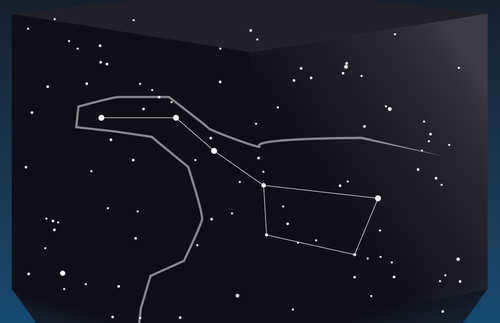
The constellation known as the Big Dipper is a well-known group of stars that is part of the third largest constellation among the 88 modern ones. Covering more than 3% of the entire sky, the Big Dipper offers not only a view of its own stars, but also a glimpse of several distant and luminous galaxies. One of these galaxies is the famous Vertushka galaxy (NGC 5457), which can be found northwest of Benetnash, the outermost star in the handle of the dipper. Today, it is understood that the five stars forming the bucket shape, excluding Dubhe and Benetnash, are part of a single star cluster known as Kolinder 285. All these stars share a common origin and motion. Located 80 light-years away from the Sun, Kolinder 285 is the closest star cluster to us and is moving towards us at a speed of nearly 50 km/s.
Alina Yeremeeva,
an expert in the field of astronomy history and a senior researcher at GAISH, Moscow State University, has shared her insights:
“The systematic observations of the stars in the Big Dipper, as described in the Chinese chronicles dating back to the 3rd millennium BC, reveal a fascinating change in the evening position of its handle. During that time, the pole was located near the alpha of the Dragon, causing the Bucket to appear as if it were revolving around it. Moreover, the orientation of the Bucket varied in different seasons. Upon closer examination of this celestial rotation, it becomes evident that it could have served as the probable inspiration for the swastika, a symbol representing eternity and the perpetual passage of time. This connection is indirectly supported by the traditional shape of one of China’s most significant inventions, the compass, which was designed in the likeness of a ladle with a handle pointing south. By gaining a deeper understanding of the true meaning behind this ancient symbol, we can hope to restore its reputation, which has been tarnished by its association with fascism.”
Once upon a time, there was a stunning nymph named Callisto who resided in the world. Zeus was captivated by her beauty, and as a result of their union, a son named Arkas was born. When Hera discovered this, she transformed Callisto into a bear. To protect their beauty, Zeus sent Callisto and their son to the heavens. This is how two constellations of varying sizes came into existence.
The constellation of the Ursa Minor. The constellation of the Ursa Minor.
According to another tale from ancient Greece, Zeus transformed the nymph Callisto into the Ursa Minor to safeguard her from Hera’s wrath. However, some versions suggest that there were two nymphs, both of whom Zeus transformed into animals that now appear in the sky as the Big and Little Dippers.
The Ursa Minor and the Ursa Major. The Ursa Minor and the Ursa Major.
In the meantime, another myth related to Zeus emerges. As per an ancient tale from Ancient Greece, the fearsome titan Kronos eliminated all of his offspring due to a prophecy stating that one of them would overthrow him. However, Zeus’ mother protected the child by hiding him in a cave, where he was cared for by the goat Amalthea and the nymphs Helis and Melissa. Eventually, the prophecy came to pass, and in gratitude, Zeus immortalized his saviors. The goat transformed into a star in the Ascendant constellation, while the nymphs forever adorned the sky with the Ursa Major and Ursa Minor constellations.
Zeus’ mother entrusts the nymphs with a child. Zeus’ mother entrusts the nymphs with a child.
Additional legends
However, there are other legends surrounding the history of this constellation. For instance, the Mongols believed that the seven stars represented wisdom and strength. As a result, they referred to it as the Seven Elders or the Seven Sages. It was even occasionally referred to as the Seven Gods, and another name for it was the Seven Blacksmiths.
– There are countless individuals who go about their lives without ever gazing upon the Big Dipper!
– They simply believe they are truly living.
The Star Without a Name
Unlike others, Tibetans have their own myth regarding the origin of the Big Dipper. According to their belief, there was once a man with a bovine head who defended the white bull against the black bull. The former symbolized good, while the latter represented evil. The malevolent witch struck the man, causing him to shatter into seven fragments. In gratitude for his valiant effort, the virtuous bull transformed these fragments into stars, thus giving birth to the constellation known as the Big Dipper.
Similarly, the Evenks have a constellation known as Haglan, which represents a celestial moose. It is often referred to as Elk. Interestingly, in the Russian North, the constellation is nicknamed Sokhaty, while the Poles call the Polar Star Losina.
Ancient Russia had a whimsical name for the Big Dipper – Horse on a Stick.





